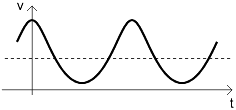Home
> urticator.net
Search
About This Site
> Domains
Glue
Stories
Computers
> Driving
Games
Humor
Law
Math
Numbers
Science
Communication
Memes for Good Driving
> Memes (2)
Other Thoughts
Other Thoughts (2)
Natural Order
Preserving Options
|
> Regulation |
Right of Way
Speed Psychology
Trucks
Wait and See
Who Is Passing Whom?
Regulation
There are a few things I do while driving that I think of as regulation.The main one is only possible under certain conditions. The traffic needs to be dense enough to be almost stop-and-go, with strong waves of braking and congestion, but not so dense that there's a lot more stopping than going. (In other words, it needs to be in the middle of a phase transition from liquid to solid.) Under those conditions, the local speed oscillates in some roughly sinusoidal way.
I like to try to suppress that oscillation, or at least to moderate it. So, what I do is, I let a large-ish gap open up in front of me, then try to drive at some speed that's a reasonable approximation of the average. And, it works! Sometimes I don't leave a large enough gap, and have to brake; and sometimes a car changes lanes into the gap and messes me up; but most of the time it really does work.
The only reason the same method doesn't work in true stop-and-go traffic is that the required gap becomes absurdly large.
So, that's the main example of regulation. It was that example I was thinking of when I mentioned frozen traffic in Models.
For example, just as a small amount of salt can melt ice by lowering its freezing point, so also might different behavior by a small fraction of drivers be able to melt frozen traffic, or effect various other large changes in its properties!
Here's a funny thing I'd never noticed before: it's not a coincidence that regulating traffic makes it regular. Both words are derived from “regula”, meaning “rule”.
The next example is closely related to the first. Normally, when I'm approaching a traffic light that's red, I just come to a stop in some efficient way, something like critical damping in a harmonic oscillator. If, however, the light is about to change to green, I sometimes like to slow down well in advance, so that by the time I reach the light, it's changed, and I don't have to stop. Of course, if there are cars stopped in my lane, I have to take that into account, so that there's time for them to come up to speed. You can see the connection, I hope—in both cases, I'm making use of a gap in traffic to smooth out my speed as a function of time.
In case you want to try this yourself, there are a couple of points I should mention. First, you have to leave a margin of error. If you zoom up to the light and it doesn't change, you are in trouble. Second, you have to keep an eye on your relative speed. It may be tempting to zoom through an empty lane just as the light changes, but it's just not smart, especially because there might be pedestrians who haven't finished crossing.
Sometimes, regulation at a traffic light would require you to slow down too much, and would annoy the cars behind you. In that case, you should just come to a normal complete stop … which brings me to my third example. You know how sometimes you get these annoying drivers who take forever to come to a complete stop? When I'm behind one of them, I like to regulate in reverse, i.e., come to a complete stop myself, and ignore the fact that the other is continuing to inch forward.
Finally, I wanted to mention the idea of creating porosity. When I started writing, I wasn't exactly sure what I meant by regulation, and I thought creating porosity might be an example of it. Now, though, I've decided that it's not, that regulation has to do specifically with velocity smoothing. Regulation and the creation of porosity do have something in common, though: they're both ways of altering the properties of traffic.
See Also
@ July (2002)
